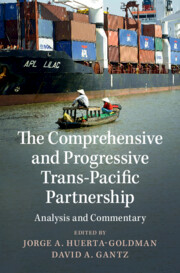Book contents
- The Comprehensive and Progressive Trans-Pacific Partnership
- The Comprehensive and Progressive Trans-Pacific Partnership
- Copyright page
- Contents
- Figures
- Tables
- Contributors
- 1 Introduction: The Trans-Pacific Partnership Becomes the Comprehensive and Progressive Agreement for TPP
- 2 Trade Agreements and the U.S. Congress – the Case of the TPP
- 3 The TPP, a Horizontal Overview
- 4 Market Access for Trade in Goods Negotiations in the TPP
- 5 Trade Provisions as Legos? How Chapter 2 of the TPP Was Influenced by WTO Negotiations and Prior US Trade Deals
- 6 The TPP, Agricultural Trade and Food Security
- 7 Rules of Origin and Origin Procedures
- 8 Trade in Textiles and Apparel Goods
- 9 How Far Beyond the TFA? Trade Facilitation in the WTO and the TPP
- 10 Treatment of Trade Remedies under the Trans-Pacific Partnership, Chapter 6
- 11 The SPS Chapter under the TPP Agreement and its Implications
- 12 Technical Barriers to Trade: Improving the Day-To-Day Functioning
- 13 Addressing the Right to Regulate in the CPTPP Investment Chapter: Identifying New Treaty Practice
- 14 Protecting Investment under NAFTA, the Trans-Pacific Partnership and the Comprehensive and Progressive TPP
- 15 The Trans-Pacific Partnership as a Development of the Australia–United States Free Trade Agreement: Services Liberalisation and Investment Protection
- 16 The TPP Agreement’s Substance and Impact on International Trade, NAFTA/USMCA, and Other FTAs: Services Overview: Background, Strategy and Solutions
- 17 Cross-Border Trade in Services (Chapter 10) and Temporary Entry for Business Persons (Chapter 12)
- 18 Financial Services in the TPP
- 19 Telecommunications Chapter in the TPP
- 20 Understanding the TPP Agreement E-Commerce Chapter
- 21 Government Procurement in the Comprehensive and Progressive Trans-Pacific Partnership Agreement: A Global Beachhead for Market Access and Good Governance
- 22 The TPP’s Competition Policy Chapter: Towards Convergence
- 23 Rules for State-Owned Enterprises in Chapter 17 of the Trans-Pacific Partnership Agreement: Balancing Market-Oriented Discipline and Policy Flexibility for States
- 24 Non-Commercial Assistance Rules in the TPP: A Comparative Analysis with the SCM Agreement
- 25 IP in the TPP: How Far Beyond the Existing FTAs Does It Go?
- 26 Strengthening Labor Rights in the Trans-Pacific Partnership Agreement: A Lost Opportunity?
- 27 TPP Trade and Environment Chapter
- 28 Horizontal Regulatory Coherence Aspects of the TPP
- 29 Transparency and Anticorruption
- 30 State-to-State Dispute Settlement under TPP Chapter 28 and NAFTA Chapter 20
- 31 Initial Provisions, Administrative Provisions, Exceptions and Final Provisions (TPP Chapters 1, 27, 29 and 30)
- Index
- References
6 - The TPP, Agricultural Trade and Food Security
Published online by Cambridge University Press: 11 November 2021
- The Comprehensive and Progressive Trans-Pacific Partnership
- The Comprehensive and Progressive Trans-Pacific Partnership
- Copyright page
- Contents
- Figures
- Tables
- Contributors
- 1 Introduction: The Trans-Pacific Partnership Becomes the Comprehensive and Progressive Agreement for TPP
- 2 Trade Agreements and the U.S. Congress – the Case of the TPP
- 3 The TPP, a Horizontal Overview
- 4 Market Access for Trade in Goods Negotiations in the TPP
- 5 Trade Provisions as Legos? How Chapter 2 of the TPP Was Influenced by WTO Negotiations and Prior US Trade Deals
- 6 The TPP, Agricultural Trade and Food Security
- 7 Rules of Origin and Origin Procedures
- 8 Trade in Textiles and Apparel Goods
- 9 How Far Beyond the TFA? Trade Facilitation in the WTO and the TPP
- 10 Treatment of Trade Remedies under the Trans-Pacific Partnership, Chapter 6
- 11 The SPS Chapter under the TPP Agreement and its Implications
- 12 Technical Barriers to Trade: Improving the Day-To-Day Functioning
- 13 Addressing the Right to Regulate in the CPTPP Investment Chapter: Identifying New Treaty Practice
- 14 Protecting Investment under NAFTA, the Trans-Pacific Partnership and the Comprehensive and Progressive TPP
- 15 The Trans-Pacific Partnership as a Development of the Australia–United States Free Trade Agreement: Services Liberalisation and Investment Protection
- 16 The TPP Agreement’s Substance and Impact on International Trade, NAFTA/USMCA, and Other FTAs: Services Overview: Background, Strategy and Solutions
- 17 Cross-Border Trade in Services (Chapter 10) and Temporary Entry for Business Persons (Chapter 12)
- 18 Financial Services in the TPP
- 19 Telecommunications Chapter in the TPP
- 20 Understanding the TPP Agreement E-Commerce Chapter
- 21 Government Procurement in the Comprehensive and Progressive Trans-Pacific Partnership Agreement: A Global Beachhead for Market Access and Good Governance
- 22 The TPP’s Competition Policy Chapter: Towards Convergence
- 23 Rules for State-Owned Enterprises in Chapter 17 of the Trans-Pacific Partnership Agreement: Balancing Market-Oriented Discipline and Policy Flexibility for States
- 24 Non-Commercial Assistance Rules in the TPP: A Comparative Analysis with the SCM Agreement
- 25 IP in the TPP: How Far Beyond the Existing FTAs Does It Go?
- 26 Strengthening Labor Rights in the Trans-Pacific Partnership Agreement: A Lost Opportunity?
- 27 TPP Trade and Environment Chapter
- 28 Horizontal Regulatory Coherence Aspects of the TPP
- 29 Transparency and Anticorruption
- 30 State-to-State Dispute Settlement under TPP Chapter 28 and NAFTA Chapter 20
- 31 Initial Provisions, Administrative Provisions, Exceptions and Final Provisions (TPP Chapters 1, 27, 29 and 30)
- Index
- References
Summary
The Trans-Pacific Partnership (TPP) agreement contains important provisions of direct relevance for agricultural trade and will therefore have important implications for rural economies, the agri-food sector, food security and nutrition in the member countries. Similar to other sectors, for agriculture the agreement includes an ambitious and comprehensive package that goes beyond eliminating tariffs and traditional non-tariff barriers to trade in goods and services, which warrants a thorough analysis of the sectoral effects and their implications for different stakeholders, including agricultural producers.
- Type
- Chapter
- Information
- The Comprehensive and Progressive Trans-Pacific PartnershipAnalysis and Commentary, pp. 121 - 161Publisher: Cambridge University PressPrint publication year: 2021



